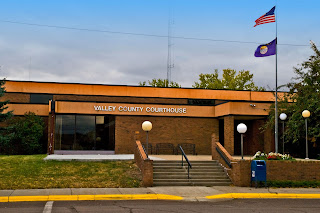 Toole County, named for Montana's first (and fourth) governor, Joseph K. Toole, was created in 1914 with land taken from Hill County (12) and Teton County (31). The Toole family has continued to be important in Montana business, politics and education, with one member currently serving on the Montana Public Service Commission.
Toole County, named for Montana's first (and fourth) governor, Joseph K. Toole, was created in 1914 with land taken from Hill County (12) and Teton County (31). The Toole family has continued to be important in Montana business, politics and education, with one member currently serving on the Montana Public Service Commission. Toole County lies east of the Continental Divide and its northern line forms the international boundary with Alberta, Canada. The county is traversed east to west by U.S. Highway 2, the Hi-Line, and the Burlington Northern Santa Fe Railroad which parallels US 2, and north to south by US Interstate 15, which has its northern terminus at the international port of entry known as Sweet Grass on the U.S. side and Coutts on the Canadian. Shelby, the Toole County seat, is a station on Amtrak's Empire Builder route.
Topographically, Toole County is far enough north and east of the Rockies to be relatively flat land, at least by Montana standards. The main exception is an isolated mountain range straddling the Toole/Liberty county line just south of the Canadian border known as the Sweet Grass Hills. These "hills" rise some 3,000 feet above the plain, and were considered sacred by the Blackfoot people who originally lived in this area. West Butte, at 6,983 feet (2,128 meters) and Gold Butte (6,512 feet) are both fully within Toole County most of which sits at 3,200-3,300 feet. The hills are easily visible from US 2, Interstate 15, and even the Crowsnest Highway in Alberta. The discovery of gold (hence Gold Butte) in 1885 brought miners to the area, and in 1888 the Blackfoot "sold" the hills and the area was opened to white settlement.
One of the few counties east of the Rockies to post an increase in population, Toole County recorded 5,324 residents in 2010, a 1.1% increase from the 2000 count of 5,267, although still down considerably from the 1960 high point of 7,904. Given the fact that most areas east of the Divide are losing population, I have to wonder if this recent increase is due to the opening of the Crossroads Correctional Center, one of the private prisons run by Corrections Corporation of America, a facility that first opened in 1999. While the inmate population would not be counted in the census, the growth of the prison brought new jobs and therefore new residents to Shelby, the Toole County seat. According to city-data.com, law enforcement is tied for second place after farming, accounting for 6% of the employed males in Toole County.
Shelby, Toole's County Seat, as is the case for so many Montana towns, got its name because of the railroad. Peter O. Shelby was president of the Montana Central Railroad, a north-south line built to connect the mines at Butte and the new city of Great Falls with the east-west Great Northern Railroad. The town has had a colorful history, being the only town in Montana to ever host a professional heavy-weight boxing match, in this case with champion Jack Dempsey going fifteen rounds against challenger Tommy Gibbons. Big Sky Fishing.com (yes, indeedy) has a wonderful write-up on the match, one that turned out to be a fiasco for the city of Shelby.
Today, Shelby is a small community of 3,500 residents, or two-thirds the population of the county. Other Toole County communities include the afore-mentioned port of entry at Sweet Grass, the town of Sunburst just south of Sweet Grass, Kevin (pronounced Kee-vin), Galata (really just a wide-spot in the road north of the Tiber Dam Reservoir), Oilmont (wonder where it got that name), Ethridge, and Dunkirk. Most of these "communities" are little more than what is left of someone's dream.
Small Town on the Prairie (Devon, Montana?)
Oil was discovered in 1922, and the oil fields between Shelby and the Canadian border continue to produce today. The formations are usually less than 2,000 feet deep, and thus cost-effective from a producer's viewpoint. Wind power is becoming increasingly important with two major wind farms currently operating or under construction in the county. While the economic power of energy cannot be denied, agriculture is still Toole County's principal mover, with twenty percent of the male population either farmers, farm managers or agricultural workers. The average sized farm covers 2,686 acres and the average value of agricultural products sold per farm is $84,977. Lest we think the Toole County farmers are making a killing at their enterprise, the average cost per farm is $96,695. Livestock and poultry (and their products) account for some 25% of the total, and 247,135 acres are planted in wheat. Sixty-five percent of all farms are family or individually owned, and the principal operator has an average age of 57. (All figures courtesy of city-data.com.)
Grain Elevators are usually the tallest structures on the prairie
Toole County's official website can be found at: http://www.toolecountymt.gov/
The city of Shelby has its website at: http://www.shelbymt.com/
Photo Information (All photos taken with a Nikon D80 DSLR and a Nikkor 16-85 mm wide angle/tele/zoom lens):
Toole County Sign: Taken 4/23/2011 along US Highway 2 at the Toole/Liberty County Line. Lens set at 85 mm. ISO 200, f /16.0, 1/90 second.
The city of Shelby has its website at: http://www.shelbymt.com/
Photo Information (All photos taken with a Nikon D80 DSLR and a Nikkor 16-85 mm wide angle/tele/zoom lens):
Toole County Sign: Taken 4/23/2011 along US Highway 2 at the Toole/Liberty County Line. Lens set at 85 mm. ISO 200, f /16.0, 1/90 second.
Railroad and Buttes (flat landscape): Taken 4/23/2011 from US Highway 2, Toole County, Montana. Lens set at 70 mm. ISO 200, f /16.0, 1/350 second.
Toole County Courthouse: Taken 10/8/2009 in Shelby, Montana. Lens set at 28 mm. ISO 250, f /8.0, 1/250 second.
Small Town: Taken 4/23/2011 from US Highway 2, Toole, County, Montana. Lens set at 85 mm. ISO 200, f /16.0, 1/500 second.
Grain Elevator: Taken 4/23/2011 from US Highway 2, Toole County, Montana. Lens set at 85 mm. ISO 200, f /16.0, 1/250 second.
Toole County Courthouse: Taken 10/8/2009 in Shelby, Montana. Lens set at 28 mm. ISO 250, f /8.0, 1/250 second.
Small Town: Taken 4/23/2011 from US Highway 2, Toole, County, Montana. Lens set at 85 mm. ISO 200, f /16.0, 1/500 second.
Grain Elevator: Taken 4/23/2011 from US Highway 2, Toole County, Montana. Lens set at 85 mm. ISO 200, f /16.0, 1/250 second.
















































